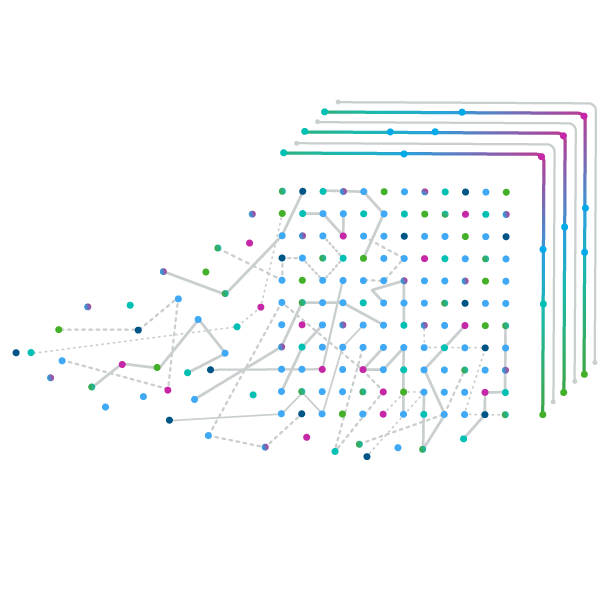From manufacturing oversight to regulatory requirements, manage quality across your organization with a single enterprise software solution.
The healthcare industry is experiencing a profound digital transformation, driven by rapid technological advancements that promise to revolutionize patient care, drug development and regulatory compliance.
This convergence of technology and healthcare offers significant benefits, including accelerated drug discovery, improved diagnostics and enhanced patient engagement. However, it also presents unique challenges due to the sector's complex regulations and intricate processes. To navigate these challenges successfully, a holistic approach to technology adoption is emerging as a best practice.
This comprehensive strategy should emphasize collaboration among diverse stakeholders, recognizes the interconnected nature of healthcare systems and addresses the critical need to align data, people and processes with new technologies. As healthcare organizations embark on this digital journey, they must balance the potential for innovation and operational performance with the imperative of maintaining patient safety, data privacy and regulatory compliance.
Part 1: Setting the Scene
We live in an era of rapid technological advancement, where the convergence of technology and healthcare is driving improvements in efficiency, compliance and, most importantly, patient outcomes. While essential, this digital transformation presents challenges across the healthcare spectrum – from drug (as well as medical devices and in-vitro diagnostic) development to FDA approval and patient care.
Integrating technology into healthcare is a complex endeavor due to the sector's stringent regulations and intricate processes. These complexities involve aligning data, people and processes with new technologies. Additionally, data literacy, leadership's role in fostering improvement and ethical/legal considerations in data management are important aspects to consider.
A comprehensive approach to technology adoption is emerging as a best practice. This strategy emphasizes the importance of a collaborative effort involving diverse stakeholders and recognizes the interconnected nature of healthcare systems.
A rich vein of benefits
There is no doubt that technology adoption across the healthcare spectrum is driving tangible value and multiple fundamental improvements, including:
- Accelerated drug discovery and development process is enhanced by computational modeling, virtual and decentralized clinical trials and advanced data analysis techniques.
- Predictive analytics for more proactive and preventative care and better chronic disease management, which can lead to better management of patients, reducing hospital readmissions.
- Better tracking and management of global health issues, including early detection and response to disease outbreaks and pandemics.
- Enhanced diagnostics, real-time patient monitoring and personalized treatment with AI and wearables. AI-powered diagnostic tools, for example, can help detect diseases earlier and more accurately.
- Leveraging big data and machine learning advances medical research. It helps identify patterns and insights that lead to new treatments and improved understanding of diseases. Technological innovations are rapidly advancing genomics and personalized medicine.
- Enabling Electronic Health Records (EHRs) and digital systems improves the organization, storage and retrieval of patient information. Improved care coordination, reduced errors and enhanced decision-making.
- Facilitating better communication between healthcare providers leads to more coordinated care and improved patient outcomes. It also improves patient-provider communication through secure messaging systems and patient portals.
- Integrating health apps and wearables gives patients more control over their health, encouraging them to take a more active role in making informed healthcare decisions and healthier lifestyle choices.
Although these benefits are substantial, the path to successful technology adoption in this complex and highly regulated environment is far from straightforward. Organizations across the global biopharma, healthcare and medical fields must negotiate several technology adoption challenges, including data privacy concerns and variability in global regulations, system compatibility and potential resistance to change, while maintaining operational efficiency and regulatory compliance — not to mention the need for significant investment.
A holistic approach to technology adoption
To maximize the benefits of the convergence of technology and healthcare and address potential challenges in this complex, regulated environment, a "holistic approach" to technology adoption is replacing traditional, fragmented strategies. Previously, healthcare organizations adopted technology in isolation, with departments pursuing separate solutions, leading to a patchwork of disconnected systems.
In contrast, a holistic approach recognizes that technology implementation in healthcare affects more than just the immediate department or function. It considers the impact on the entire organization, including clinical workflows, patient safety and regulatory compliance, as part of a broader technological ecosystem. This perspective leads to a more integrated approach to technology adoption, involving a broader range of stakeholders from the start. The role of IT leadership, particularly Chief Information Officers, is evolving to oversee all IT systems, improving coordination and integration — critical for interoperability that impacts patient care and safety.
A holistic approach also acknowledges the interconnectivity of systems and the value of data-driven insights across healthcare delivery. It does not, however, mean relying on a single vendor. Maintaining relationships with multiple technology providers ensures flexibility, encourages innovation and reduces risks associated with over-reliance on one source.
Aligning data, people and processes
One of the biggest challenges when adopting new technologies is aligning an organization’s data, people and processes. A common pitfall is insufficient involvement from all relevant parties from the project's inception, leading to a lack of buy-in or misalignment with actual needs. Conversely, IT departments may dominate the procurement process without consulting with professionals who will use the system. Another issue is viewing new technology as a panacea for existing process issues in healthcare. This underscores the need to evaluate and optimize clinical and operational processes before implementation, rather than expecting the technology to solve all problems.
Organizations must recognize their position in the digital journey. The approach and benefits vary based on whether an organization is transitioning from paper-based systems to digital for the first time or harmonizing multiple existing digital systems that may significantly vary in their approach to managing the same documented process.
Successful technology adoption requires thorough preparation, stakeholder involvement and a realistic assessment of what technology can achieve. Healthcare organizations must ensure their processes are sound before integrating new technologies and data sources. Each scenario requires a different change management and communication strategy. If compliance issues drive technology adoption, relying solely on modern technology to resolve regulatory problems can lead to digitizing broken processes, potentially worsening existing issues and compromising patient care. As these transformation journeys can take time, it is also key to invest in a communication plan that clearly telegraphs the benefits of adoption of new technology and celebrates the wins and key milestones throughout the project.
Related solutions
Outdated compliance practices aren't viable amid evolving market and regulatory changes. IQVIA’s award-winning, end-to-end quality management system streamlines the product value chain, accelerates market entry, safeguards companies and patient safety, and meets complex regulatory demands.
IQVIA SmartSolve® Fundamentals is a cloud-based QMS for small biopharma companies. It automates CAPA, Deviation, Document, and Change Management to ensure compliance with minimal IT resources.


























